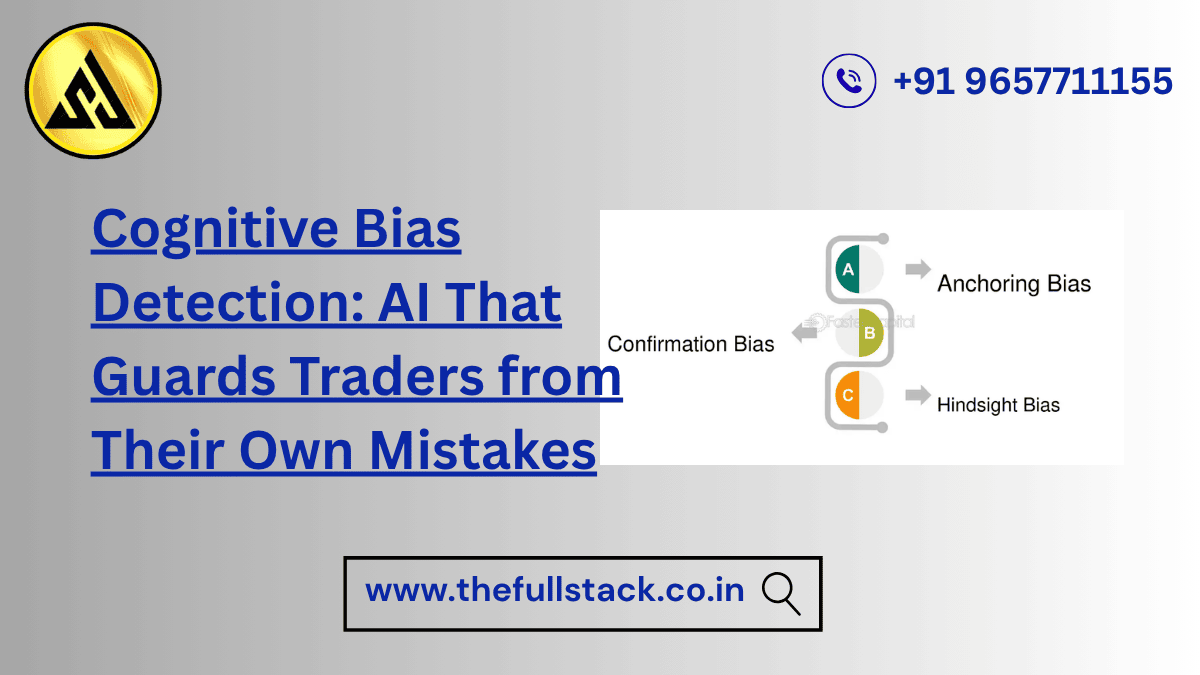
Cognitive Bias Detection: AI That Guards Traders from Their Own Mistakes
Trading is as much about psychology as it is about numbers. Ask any seasoned trader, and they’ll tell you that the hardest part of investing isn’t predicting the market—it’s controlling your own mind. Emotions like fear, greed, or overconfidence can cloud judgment, leading to costly mistakes.
This is where Cognitive Bias Detection powered by AI steps in. Instead of replacing traders, AI acts like a safety net, catching biases before they sabotage decisions. For beginners, understanding this concept could be the difference between consistent growth and repeated frustration.
In this blog, we’ll explore what cognitive biases are, how they impact trading, and how AI is now being used to detect and prevent these mental traps. Whether you’re a general reader exploring financial literacy or a company employee working in finance, this guide will help you see how the future of trading psychology meets technology.
What Are Cognitive Biases in Trading?
Cognitive biases are mental shortcuts or thought patterns that often lead to irrational decisions. While they help us survive in everyday life, in trading they can become dangerous.
Here are some of the most common trading-related biases:
- Loss Aversion – Fear of losing makes traders hold onto bad positions too long.
- Confirmation Bias – Traders seek only the information that supports their existing beliefs.
- Overconfidence Bias – After a few wins, traders believe they can’t be wrong.
- Herd Mentality – Following what everyone else is doing, regardless of logic.
- Anchoring – Sticking to an initial reference point (like a stock’s previous price) even when the market changes.
These biases don’t just affect beginners—they impact professionals too. The difference is, pros often have systems (and discipline) to counter them.
How Biases Impact Trading Decisions
Imagine this scenario:
You buy a stock at $100. It drops to $80. Instead of cutting losses, you wait, telling yourself, “It’ll bounce back.” That’s loss aversion.
Or let’s say a news article confirms your belief that crypto is the future. You ignore all other warnings and invest heavily. That’s confirmation bias.
Individually, these may seem harmless. But over time, unchecked biases drain portfolios and confidence.
The Role of AI in Detecting Cognitive Biases
Here’s where AI shines. Unlike humans, AI doesn’t feel emotions. It analyzes data, patterns, and behavior objectively.
Modern trading platforms now integrate AI-powered bias detection systems that:
- Monitor Trading Patterns: Detect repeated emotional mistakes like panic selling.
- Flag Risky Behavior: Warn traders if decisions deviate from long-term strategy.
- Provide Explanations: Explain why a decision might be biased (e.g., “You’re holding this stock due to loss aversion”).
- Suggest Alternatives: Offer rational, data-driven options to counter bias-driven choices.
Think of AI as your rational co-pilot, guarding you from yourself.
Real-World Applications
- Retail Trading Apps – Apps like Robinhood and Zerodha are exploring AI-driven alerts that nudge users when they’re trading impulsively.
- Institutional Platforms – Hedge funds and banks are testing AI to monitor trader behavior for compliance and performance consistency.
- Personal Finance Tools – Robo-advisors integrate bias detection to keep everyday investors disciplined.
For example, an AI dashboard might say:
“You’ve checked this stock 12 times today. High emotional involvement detected. Consider reviewing your strategy before making a decision.”
This feedback is priceless for beginners still learning to manage emotions.
Market Trends and Industry Insights
The adoption of cognitive bias detection is part of a bigger trend:
- Behavioral Finance Meets AI – The combination of psychology and technology is becoming a mainstream strategy.
- Regulation and Compliance – Financial regulators encourage transparency and responsible decision-making, making bias detection essential.
- Demand for Smarter Tools – With more retail traders entering markets post-pandemic, platforms are adding features to help users avoid emotional trading.
Industry experts predict that within the next 5–10 years, bias-detection AI will become as standard as stop-loss orders.
Practical Tips for Beginners
While AI helps detect biases, you can also train yourself:
- Keep a Trading Journal – Record your decisions and emotions to spot patterns.
- Set Clear Rules – Use pre-set entry and exit points to avoid emotional reactions.
- Embrace Small Losses – Learn to cut losses early instead of waiting for recovery.
- Diversify – Don’t let overconfidence push you into concentrated bets.
- Leverage AI Tools – Use platforms with bias detection features to get real-time feedback.
Over time, you’ll start to notice when emotions are taking over—and act more rationally.
Relatable Example for Beginners
Think of trading like driving. You may know the rules, but in stressful moments (traffic jams or sudden turns), you might overreact. An AI driving assistant reminds you when you’re speeding or drifting.
Bias detection AI works the same way. It’s not there to drive for you—it’s there to keep you safe on the road to financial success.
The Future: Smarter, More Human-Friendly Trading
The future of trading won’t be machines replacing humans—it will be machines helping humans overcome human flaws. AI bias detection is part of a broader push toward human-friendly finance, where technology empowers rather than intimidates.
For beginners, this means you no longer need to fear your emotions ruining your strategy. With AI as your guard, you can trade with clarity, confidence, and consistency.
Conclusion: Mastering Yourself with AI’s Help
As the saying goes, “The biggest enemy of a trader is the trader themselves.” Cognitive biases are natural, but they don’t have to define your financial journey.
With AI-powered bias detection, you get a powerful tool to recognize, counter, and learn from your own mistakes. That’s the first step toward financial literacy and long-term success.
👉 Ready to level up your trading skills?
Explore our advanced learning resources and courses on AI and trading psychology. Let’s work together to turn your financial decisions into informed, bias-free strategies.
You may be also like this:-
What is SQL? A Simple Guide to Databases and Queries


Leave a Reply